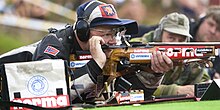Primary extraction


Inbreechloadingfirearms,primary extractionis the initial phase (the first few millimeters) of theextractionof a spentcasingfrom the firearmchamber.[1]After the primary extraction comes the secondary extraction where the bolt is moved further backwards,[2]and the extraction is then normally finished with the spent cartridge being ejected.
The first few millimeters of extraction tend to require a much higher peakforcethan the rest of the extraction due to the spent casing sticking against the chamber walls. The case is not chemically sticking as it still rotates with the bolt, gripped by the extractor claw on the rim. The mechanical sticking effect is a result from the case having expanded due to the high pressures during firing, and the extra initial force required can, depending on firearm design, make the extraction difficult for the user. Selfloading rifles usually don't have a separate motion for primary extraction, but instead depend on using a lot of force in order to start the extraction.
Different designs are used for ensuring reliable extraction in manual mechanisms, with most of them being based on the principle ofmechanical advantage.The camming action seen in manybolt-actionrifles is an example of mechanical advantage being used for chambering and extraction. There are examples of some firearm designs being less successful due to poor design around the primary extraction, which can result in a stuck case in the chamber.[3]Notably somepumpandstraight pullmechanisms are perceived as having the advantage over bolt actions that they are faster and require fewer body movements to operate by the user,[citation needed]however, they are often more complex than traditional bolt action designs, and often have little or no primary extraction[4]lacking the mechanical advantage of a turn bolt[5]which can lead to stoppages. There are some examples of straight pull[4]and pump action rifles notorious for having extraction problems.[citation needed]
TheBlaser R8straight-pullrifledesign has been reported to have no issues with primary extraction.[6]In this design, the bolt head moves in a purely linear motion, and except for the bolt handle cam when opening or closing the action, operation by the shooter is also purely linear. TheHeym SR 30is another successful straight-pull design which features aboltwith ball bearings as locking elements. Here the primary extraction is performed by retracting the bolt handle, which uses leverage from the opposite side of the bolt to swing the handle to the open position, giving a mechanical advantage.
See also
[edit]References
[edit]- ^Savage Shooters - Primary Extraction: What is it?
- ^Do-It-Yourself Gun Repair: Gunsmithing at Home - Edward A. Matunas - Google Books
- ^Bommarito Rifle – Forgotten Weapons
- ^abSwiss Straight-Pull First Impressions – Forgotten Weapons
- ^Break That Case: A Visceral Illustration of Primary Extraction, with Bloke on the Range - The Firearm BlogThe Firearm Blog
- ^Blaser R8 | Straight-Pull Rifles Reviews | Gun Mart
